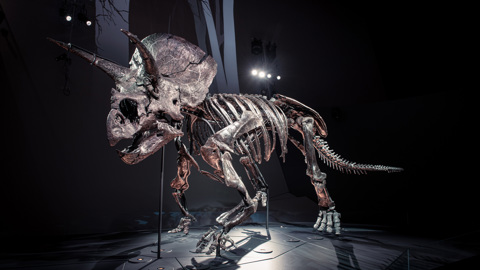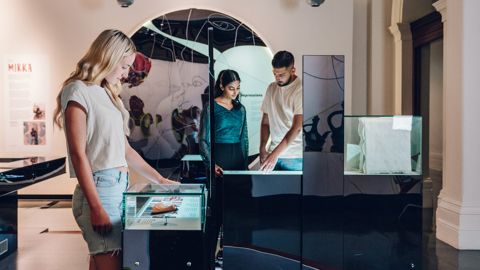News
We’re Looking for Volunteers
ON APRIL 8, 2019 BY GMT
Volunteers and staff with components of the Great Melbourne Telescope set-up at Moreland Annexe
A team of enthusiastic volunteers, supported by Museums Victoria, have been actively working since 2008 to restore the iconic Great Melbourne Telescope for a return to its original location at the Melbourne Observatory adjacent to the Royal Botanic Gardens.
The telescope was significant as the first large telescope with an equatorial mount and clockwork drive, allowing automated tracking of celestial objects. This year the telescope celebrates the 150th anniversary of its installation.
We are currently searching for volunteers with skills in mechanical engineering, machine fabrication and/or CAD drafting to join the restoration project on Tuesdays and/or Thursdays at Scienceworks, Spotswood.
In you have the necessary skills and would like to join the project, then please click on the ‘Apply now’ button below and complete the online form.
Apply now
Applications close 5pm, Monday 15 April 2019. General information about becoming a volunteer is available on the Museums Victoria website.
The Great Melbourne Telescope on ABC Australia Wide
ON FEBRUARY 2, 2017 BY GMT
ABC cameraman Michael Barnett has been checking in every now and then on our restoration progress since the project began in 2008. His following video first aired as a segment on the ABC Australia Wide program on 26 November 2016.
It features Richard Gillespie (Head of Humanities, Museums Victoria), Jim Pollock and Dr Barry Clark (Astronomical Society of Victoria members and Research Associates at Museums Victoria), Tim Entwisle (CEO, Royal Botanic Gardens Victoria), Nev Quick (Collection Storage & Logistics Manager, Museums Victoria) and a host of volunteer team members working on the project.
A thousand words by Liz Clarkson
ON AUGUST 30, 2016 BY GMT
A man in a high-vis vest measuring with a ruler
Mal Poulton working on the GMT restoration project
Photographer Liz Clarkson visited our restoration workshop this month to photograph the team and research an article for the online publication The Northsider. Here is a link to her article about the project, called “First Light & Dark Matter”.
Technically though, our telescope saw “first light” in the Northern Hemisphere when it was being first commissioned and tested at the workshop of its maker, Thomas Grubb, in Dublin in 1868. It’s “first light” in the Southern Hemisphere was in 1869 at the Royal Botanic Gardens in Melbourne.
Historic Eyepieces Under ‘Forensic’ Examination
ON JULY 4, 2016 BY GMT
The historic Great Melbourne Telescope of 1869 originally utilised Huygenian (pronounced “high-gee-knee-yan”) eyepieces. These original eyepieces still exist and are preserved in Museum Victoria’s collection, but the precise specification of these eyepieces was not fully known. Recently a thorough and detailed measurement of each eyepiece was conducted. The overall dimensions of each eyepiece element and the curvature of the lenses were measured, and a Foucault knife edge test was performed to determine the focal lengths.
ASV volunteer Barry Adcock utilised his own home made equipment to perform the Foucault knife edge test.The test measured the back focal length of the eyepiece lens, using red, yellow and blue LED light sources. The figures obtained were used to calculate the refractive index at each colour and thus the dispersion of the glass. Both refractive index and dispersion are necessary in order to specify the glass used.
Group of men in a workshop with technical equipment
Barry Adcock peering through his Foucault test rig in the workroom at the Museum.
Source: Stephen Bentley
The Foucault test can be illustrated using the exaggerated diagram below. The light source is narrowed to simulate a point source similar to a star. The light rays pass through the lens being tested and are reflected off a flat mirror behind the lens. The reflected light passes back through the lens again and is observed at the knife edge at the place of the original LED light source. The spacing between the lens and the knife edge is adjusted (while the eye remains still and can still see the light source), until the reflected image of the light source looks to be shadowed, i.e., is nulled. At this point the system is in focus and the back focal length can be measured with a rule as the spacing between the lens and the knife edge. Calculations are then performed to determine the actual focal length of the lens.
Diagram of telescope workings
Diagram of Barry’s Foucault test.
Source: Stephen Bentley
The curvature of the eyepiece lenses was measured using a spherometer. The spherometer has a micrometer located centrally in the circular tool. Around the perimeter on the base of the tool there are three ball bearings held captive in a triangle formation in a precision machined groove.The diameter of the spherometer base may come in different sizes to measure different sized lenses. The spherometer is first calibrated on an optically flat piece of glass so that the micrometer central point and ball bearings are all in equal contact with the surface of the flat glass plate. The spherometer is then placed onto the lens to be tested and the micrometer adjusted to record the sagitta, which is the difference between the plane of the ball bearings relative to the position of the centrally located micrometer point.
Gloved hands holding a telescope component
Base of a small spherometer, precisely fabricated by Barry Adcock.
Source: Stephen Bentley
Engineering test equipment
Engineering test equipmentEngineering test equipmentEngineering test equipment
Once the curvature and focal length of a lens are known, the refractive index of the glass can be calculated. This data is essential to design new replica eyepieces for use with the restored telescope and it also gives an insight to the availability and specification of optical glass of the 1860s.
Our ASV GMT Team Members at NACAA
ON APRIL 18, 2016 BY GMT
Over the Easter weekend (25-28 March), the biannual National Australian Convention of Amateur Astronomers (NACAA) was held in Sydney. Barry Clark, one of our restoration team’s members (and ASV volunteer) presented a poster paper entitled “Progress report on reconstruction of the Great Melbourne Telescope”. Other ASV team members who attended were Barry Adcock, who presented a paper “Infrared studies of the atmosphere of Jupiter”, Barry Cleland and Ian Barry.
Barry Clark said that many delegates showed a considerable interest in the project.
The NACAA is a biannual event and it was last hosted by the ASV Victoria group in 2014 and it included a visit to the GMT workshop.
Posters pinned to a board
Poster presentation at NACAA by Barry Clark.
Image Source: Barry Adcock
Download a copy of the report – Progress report on reconstruction of the Great Melbourne Telescope (PDF, 1.7MB)
A Special Excursion for ASV Members
ON MARCH 21, 2016 BY GMT
On Saturday 19th March 2016, we hosted an excursion to our GMT Workshop for 19 members of the Instrument Making Section of the Astronomical Society of Victoria. The members had a keen interest in how the project was progressing. Many had not seen the project before and were impressed with the scale of the telescope and the goals of the project.
A special thank you to Museum Victoria staff members, Nev Quick and Matthew Churchward, who volunteered to open the workshop ‘out of hours’ and supervise this visit, and the seven ASV GMT project volunteers who hosted the visit.
Two men inspect a large circular mirror
Steve Pattie (ASV GMT volunteer) and Mark Justice (Director of Instrument Making Section, ASV) inspecting the speculum mirror of the Great Melbourne Telescope.
Image Source: Matthew Churchward
Heritage Victoria Tour the GMT Workshop
ON MARCH 7, 2016 BY GMT
Staff from Heritage Victoria visited our GMT workshop on Thursday 3rd March 2016 for a special excursion to check out progress on the restoration project. Director of Museum Victoria, Patrick Greene, hosted the visit and Richard Gillespie (Head, Museum Victoria, Humanities) was on hand to talk about the history of the telescope. Curators, Matthew Churchward and Matilda Vaughan provided a review of the progress on the restoration project and its technical challenges.
A group of people gathered in a workshop
Staff members from Heritage Victoria in the GMT workspace.
Image Source: Matilda Vaughan
Group of people reflected in a large morror
A reflective moment in the mirror for Matthew, Richard, Tim Smith and Patrick Greene.
Image Source: Matilda Vaughan
A group of people viewed through a metal lattice
Through the telescope lattice tube section.
Image Source: Matilda Vaughan
Phoenix, Issue 11 now available
ON APRIL 13, 2015 BY GMT
All the latest GMT news, including details of the upcoming optical design workshop.
Phoenix Newsletter – Issue 11, April 2015 (3.9MB)
The 150th Anniversary of Melbourne Observatory
ON JUNE 24, 2014 BY GMT
Melbourne Observatory had a long wait for an “official” opening – 150 years, to be precise. After a decade of astronomical operations, the Williamstown Observatory was closed and a transfer of equipment took place in 1863 to grand new facilities on land excised from the Government House reserve, adjacent to the Royal Botanic Gardens.
CONTINUE READING “THE 150TH ANNIVERSARY OF MELBOURNE OBSERVATORY”
Engineering Work Begins
ON JANUARY 29, 2014 BY GMT
Having achieved an adequate degree of documentation of the GMT parts, we have developed more than 40 written proposals for engineering work on some of the parts, and on a frame to hold the entire telescope.
CONTINUE READING “ENGINEERING WORK BEGINS”
Sponsorships!
ON MAY 29, 2013 BY GMT
We are pleased to report that the Copland Foundation has pledged support of $70,000 to the Great Melbourne Telescope Restoration project.
We also have generous offers of support in kind from engineering companies, including Marand Precision Engineering, Pizzey Engineering and United Service Technologies.
CONTINUE READING “SPONSORSHIPS!”
Restoration Work Surges Forward!
ON NOVEMBER 20, 2012 BY GMT
The ASV team is very proud to report that we have come through the “hard yards” of Stage 1 of the GMT Restoration Project (dismantling, drawing and cataloguing), and we are now comfortably progressing into the “sweeter metres” of Stage 2 (design and construction).
CONTINUE READING “RESTORATION WORK SURGES FORWARD!”
Slow but steady progress
ON MARCH 29, 2012 BY GMT1 COMMENT
With slow but steady progress; we are now at workshop #125. We have catalogued all the GMT parts, cleaned them, understood them, and are halfway through photographing, describing and documenting them; so far about 500 pages of optical, mechanical and electrical engineering plans have been drafted. Some broken castings have also been repaired.
CONTINUE READING “SLOW BUT STEADY PROGRESS”
Governor joins advisory group
ON JULY 19, 2010 BY GMT
The Governor of Victoria, Professor David de Kretser, has agreed to join the advisory group for the project. Professor de Kretser is one of several community leaders, educators and astronomers who have expressed enthusiasm for the project. We are very grateful for their support and advice. See the full list.
Progress in restoration
ON JULY 18, 2010 BY GMT1 COMMENT
The restoration team is making great advances in cleaning and describing the hundreds of parts of the telescope. They are undertaking the arduous task of removing layers of paint, preparing detailed technical drawings, and undertaking crack testing of critical parts.
CONTINUE READING “PROGRESS IN RESTORATION”
Exposure of the lattice tube
ON NOVEMBER 30, 2009 BY GMT
Every photograph of the original GMT shows its telescope tube, the lower part being sheet metal and the longer, upper part comprised of a criss-cross lattice of metal strips. This design was intended to save weight and reduce wind drag in the upper part of the tube.
CONTINUE READING “EXPOSURE OF THE LATTICE TUBE”
Removal of declination axis and fittings from the cube
ON NOVEMBER 15, 2009 BY GMT
A previous news item reported the disassembly of the northern end of the combined axis assembly. The next big job was to remove the declination axis from the cube – an undertaking of similar magnitude, which similarly occupied several Wednesdays and many challenges.
The five major pieces – cube, northern cone, southern cone, bell housing and declination axis – are now resting on their respective pallets, a joy to behold and a sight to gladden the heart of a tired telescope dismantler.
See the article in Phoenix Newsletter – Issue 3, November 2009 (PDF 597KB) for a blow by blow account.
More archival material
ON NOVEMBER 1, 2009 BY GMT
Jim Pollock of the ASV restoration team has come across some more historical photographs, showing the newly-made GMT standing in Grubb’s Dublin factory in 1868, attended by Irish workers clad in hats, waistcoats and beards. Torn and faded depictions of a scruffy old industrial yard may be dull to most people, but these dog-eared daguerrotypes sent Barry Clark into excursions of ecstasy. Some hitherto baffling technical questions can now be answered by scrutiny of these photos.
Read more in Phoenix Newsletter – Issue 3, November 2009 (PDF 597KB).
Removal of hour angle drive gear from northern cone
ON AUGUST 10, 2009 BY GMT
This mighty effort was our frst job – I won’t call it a baptism of fire, as the GMT has already had one – and is best described as four tasks.






